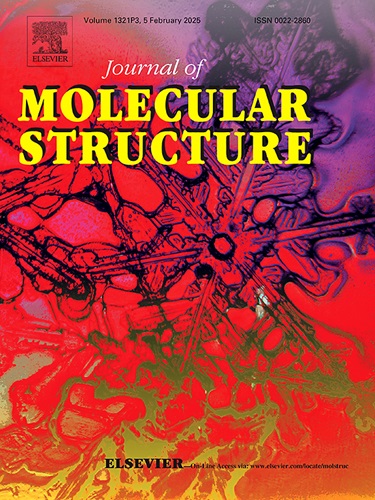Blue-red self-calibrating signals for aqueous oxygen from a composite structure of carbon dots and Ru probe
IF 4
2区 化学
Q2 CHEMISTRY, PHYSICAL
引用次数: 0
Abstract
The detection of dissolved oxygen in aqueous solutions is an important issue in various fields. In this work, we prepared efficient blue-emitting carbon dots (CDs, emission wavelength=453 nm, quantum yield=25.8%)) using the fibers of Euonymus bungeanus as a starting material through a classic hydrothermal method, serving as the reference, and red-emitting Ru(II) compounds (emission wavelength=705-710 nm, quantum yield=9.2-10.4%), which harvested the blue emission and were thus excited by the CDs, serving as the probe. Ru(II) complexes with terpyridine-derived ligands having different bonding groups (-NH2 and -COOH) were compared to find the optimal sensing performance. The covalent bonding between the carbon dots and the Ru(II) probe was expected to exhibit ratiometric sensing signals for dissolved oxygen. The Ru(II) probes and the CDs were discussed carefully, including single molecular structure, electronic transition, absorption, emission, excitation, quantum yields, and lifetime, which confirmed an energy transfer from the CDs to the Ru(II) probe. The resulting composite sample (denoted as Ru1@CDs) was analyzed by micromorphology analysis, XRD, IR, and elemental analysis. A probe loading level was determined as 18.45%, with an energy transfer efficiency (CDs → probe) as high as 26.3%. Ru1@CDs showed good sensing selectivity and a linear correlation with the concentration of dissolved oxygen, with a fitting equation of , a LOD of 0.12 mg/L, and a short response time of ∼140 s. The sensing mechanism was proven as a dynamic collision between the Ru(II) probe and O2. The novelty of this work was the combination of two luminescent components and the corresponding emission color change from deep-red at low [O2] levels (∼0.6 mg/L) to blue at high [O2] levels (∼10 mg/L).
碳点和钌探针复合结构的水氧蓝红自校准信号
水溶液中溶解氧的检测是各个领域的一个重要问题。本研究以羽矛纤维为原料,采用经典水热法制备了高效的蓝色发射碳点(CDs,发射波长为453nm,量子产率为25.8%)作为参比,并以发射红光的Ru(II)化合物(发射波长为705 ~ 710nm,量子产率为9.2 ~ 10.4%)作为探针,收获了蓝色发射,并被CDs激发。Ru(II)配合物与具有不同键基(-NH2和-COOH)的三联吡啶衍生配体进行了比较,找到了最佳的传感性能。碳点与Ru(II)探针之间的共价键被期望对溶解氧表现出比例传感信号。对Ru(II)探针和CDs进行了详细的讨论,包括单分子结构、电子跃迁、吸收、发射、激发、量子产率和寿命,证实了从CDs到Ru(II)探针的能量转移。通过微观形貌分析、XRD、IR和元素分析对所得复合样品(表示为Ru1@CDs)进行了分析。探针负载水平为18.45%,能量传递效率(CDs→探针)高达26.3%。Ru1@CDs具有良好的传感选择性,与溶解氧浓度呈线性相关,拟合方程为I0/I=1.462+3.716·[O2], LOD为0.12 mg/L,响应时间短,约140 s。该传感机制被证明是Ru(II)探针与O2之间的动态碰撞。这项工作的新颖之处在于两种发光成分的结合,以及相应的发射颜色从低[O2]水平(~ 0.6 mg/L)的深红色到高[O2]水平(~ 10 mg/L)的蓝色变化。
本文章由计算机程序翻译,如有差异,请以英文原文为准。
求助全文
约1分钟内获得全文
求助全文
来源期刊

Journal of Molecular Structure
化学-物理化学
CiteScore
7.10
自引率
15.80%
发文量
2384
审稿时长
45 days
期刊介绍:
The Journal of Molecular Structure is dedicated to the publication of full-length articles and review papers, providing important new structural information on all types of chemical species including:
• Stable and unstable molecules in all types of environments (vapour, molecular beam, liquid, solution, liquid crystal, solid state, matrix-isolated, surface-absorbed etc.)
• Chemical intermediates
• Molecules in excited states
• Biological molecules
• Polymers.
The methods used may include any combination of spectroscopic and non-spectroscopic techniques, for example:
• Infrared spectroscopy (mid, far, near)
• Raman spectroscopy and non-linear Raman methods (CARS, etc.)
• Electronic absorption spectroscopy
• Optical rotatory dispersion and circular dichroism
• Fluorescence and phosphorescence techniques
• Electron spectroscopies (PES, XPS), EXAFS, etc.
• Microwave spectroscopy
• Electron diffraction
• NMR and ESR spectroscopies
• Mössbauer spectroscopy
• X-ray crystallography
• Charge Density Analyses
• Computational Studies (supplementing experimental methods)
We encourage publications combining theoretical and experimental approaches. The structural insights gained by the studies should be correlated with the properties, activity and/ or reactivity of the molecule under investigation and the relevance of this molecule and its implications should be discussed.
 求助内容:
求助内容: 应助结果提醒方式:
应助结果提醒方式:


